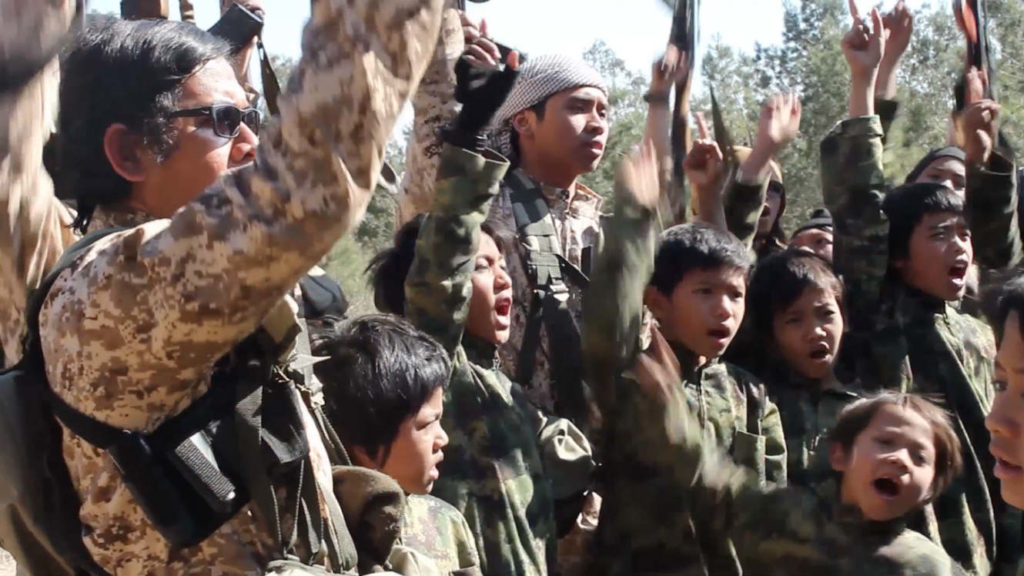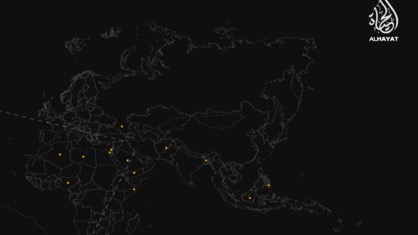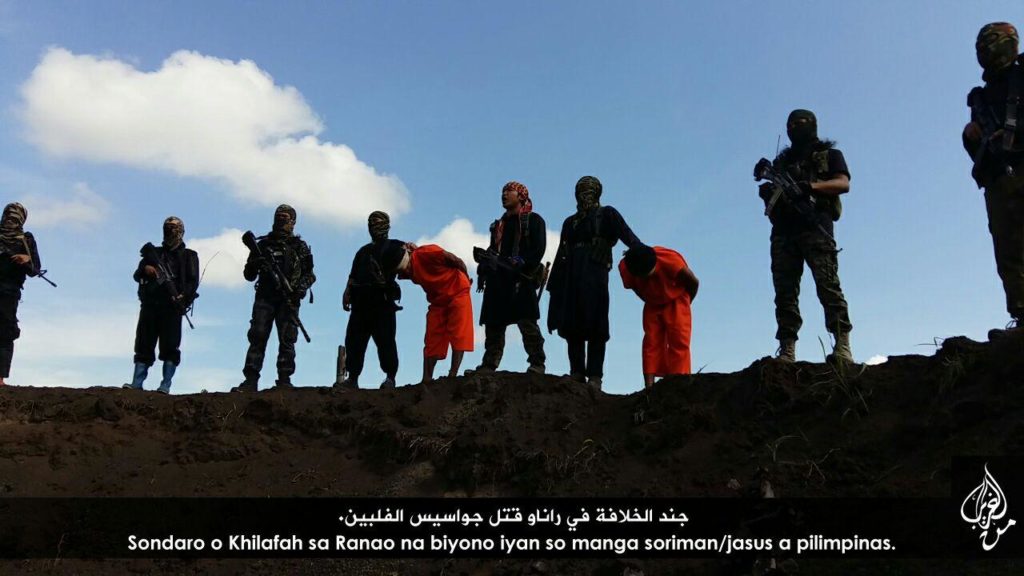Signs of a Nascent Islamic State Province in the Philippines

In last week’s issue of al-Naba’, the Islamic State’s weekly newspaper, an article claimed that “soldiers of the Caliphate” in the southern Philippines had killed around 300 members of the “Crusader Filipino Army” in the last few weeks, and forced around 2,000 others to retreat. It went on to report that a number of new jihadist brigades in the archipelago state had joined their brethren in pledging allegiance to Abu Bakr al-Baghdadi, the Islamic State’s self-proclaimed caliph. This came on the back of a video that was released two days earlier by the organization’s Barakah Province Media Office in Syria, in which Filipino immigrants – children and adults – were filmed burning their passports alongside fighters from Malaysia and Indonesia.
While the claims in the article should be taken with a hefty pinch of salt, given its provenance, these reports are the latest in a series of events that point towards increasing coordination, cooperation, and cohesion between jihadists in South East Asia and the Islamic State in Syria and Iraq. According to media reports, which were only last year speaking of the region as the organization’s new breeding ground, the southern Philippines is now so at risk from jihadist terrorism that, in some areas, tourists are being asked to sign waivers before going to the beach.
Whether or not such precautions are necessary, it is now undeniable that Islamic State-branded activities are occurring with accelerating regularity in the Philippines. And, as a direct result of them, suspicions are being raised that al-Baghdadi’s caliphate may be set to establish its newest province in the country before too long.
That’s all well and good, but the difference between being an Islamic State “fan” and an Islamic State “affiliate” is profound. Claiming that operations are being carried out in the organization’s name is not the same as carrying out operations at the organization’s behest. Thus, decoding the extent of these ties is crucial. To this end, it serves to examine the situation longitudinally through the lens of propaganda. Such an approach yields plenty of reasons to suggest that these suspicions are correct, that a fully ratified “Philippines Province” of the caliphate could well be on the horizon.
As the experiences of West Africa and the Caucasus attest to, before an Islamic State province is formally established, there are a great deal of covert intra-group negotiations and transactions, complemented by overt intra-group signaling. On the Islamic State’s part, it wants to demonstrate that it is ready and able to accept, integrate, and celebrate new pledges. As for the prospective candidate, communications are used to assert both organizational and ideological cohesion and provide proof that, if and when a province is established, it will be a regional hegemon. After all, as the Islamic State has itself declared, new provinces are only deemed to be strategically viable if there is a stable, trustworthy, and resilient leadership hierarchy already in place.
We can see much happening in southern Philippines that fits the pattern of events that came ahead of the establishment of both the West Africa and Caucasus Provinces. However, while it is only now that it is being picked up by the media, this signaling is not new. It is just a marked acceleration of reciprocal communications that have been going on for a number of years.
Eighteen months ago, in November 2014, Dabiq reported that “a number of groups” in, among other places, the Philippines, had pledged allegiance to al-Baghdadi.  A few months later, the Islamic State’s official spokesman, Abu Muhammad al-‘Adnani, made a direct appeal to Filipino Sunnis, calling on them to resist incursions from the “Crusaders-Safavid alliance.” Later, in a world map graphic that appeared at the beginning of the November 2015 video “No Respite,” a pinprick of light shone brightly from the Philippines, along with the rest of the Islamic State’s formalized territorial claims. And, in his most recent public address, al-Baghdadi himself called for Filipinos in particular to “rise against the apostate tawaghit [tyrants].”
A few months later, the Islamic State’s official spokesman, Abu Muhammad al-‘Adnani, made a direct appeal to Filipino Sunnis, calling on them to resist incursions from the “Crusaders-Safavid alliance.” Later, in a world map graphic that appeared at the beginning of the November 2015 video “No Respite,” a pinprick of light shone brightly from the Philippines, along with the rest of the Islamic State’s formalized territorial claims. And, in his most recent public address, al-Baghdadi himself called for Filipinos in particular to “rise against the apostate tawaghit [tyrants].”
That same month, content that seemed to originate in the Philippines began to surface on official Islamic State channels. In December, a video of an “Islamic State training camp” in the Mindanao island group began doing rounds on social media. Then, about a month after the attack on Jakarta in January 2016, the official Furat Media Center released a video eulogizing Abu Anas al-Muhajir, a prominent Malaysian jihadist who was killed by the Filipino army on Basilan island, also in the Mindanao group. Interestingly, this video, which was disseminated through Islamic State channels reserved exclusively for official propaganda, featured footage that had been filmed in the Philippines. A month later, another Furat Media video surfaced, in which members of an Abu Sayyaf Group battalion were shown pledging allegiance to al-Baghdadi. Once again, this footage, which was disseminated through an Islamic State media channel reserved solely for official content, was filmed in the Philippines.
Responding to these entreaties from Islamic State central, the Filipino prospects have continued to proactively integrate their communications into the caliphate brand and present their propaganda with increasingly Islamic State-esque precision. Motifs associated primarily with al-Baghdadi’s organization – for example, orange-uniformed prisoners having their heads sawn off and young children receiving weapons training as “cubs” – are now regular features in Filipino jihadist media.
As past cases have shown, signaling like this is not just complimentary. In January 2015, for example, Boko Haram set up the al-‘Urwa al-Wuthqa Twitter handle. This was used by the group to disseminate its newly revamped media – photo reports and videos that borrowed much from Islamic State’s propaganda playbook. Two months after al-‘Urwa al-Wuthqa surfaced, along with its new, higher spec propaganda, Abubakar Shekau’s fealty to al-Baghdad was publicized far and wide. Clearly, this was about more than just mimicry.
One year on, in a manner that is strikingly reminiscent of the above, Filipino prospects have also been centralizing their media dissemination. Now, they have two official Telegram channels, one operating in Arabic and Tagalog, and the other English. And, just like Boko Haram did in the run up to its symbolic transformation, they have started to use Islamic State nasheeds as jingles, drones for ambitious filming, and post-production techniques to ramp up their graphical sophistication. Further, a number of videos have been circulated in which various Filippino factions are depicted collectively pledging allegiance to al-Baghdadi, just like those that emerged in the months that preceded the establishment of Caucasus Province.
What’s more, looking beyond propaganda, the Islamic State has itself claimed responsibility for four separate operations in the Philippines since the beginning of the year, aside from this most recent report in al-Naba’: one in March that led to the capture of 20 troops; one in April, in which 100 soldiers were said to have been killed; and two more in May, one of which resulted in the abandonment of an army position in Maluso, the other involving a bomb attack in Basilan.
Closely aligned, interacting, and occasionally overlapping media strategies do not mean that the establishment of “Philippines Province” is a foregone conclusion. They do, however, demonstrate that jihadists in South East Asia have a direct line into the caliphate’s central media office, one that they have used multiple times to claim attacks in its name. Given the profoundly opaque nature of the Islamic State’s media infrastructure, the importance of this should not be underestimated.
The organizational distance between the Philippines and the Islamic State’s central nexus is unambiguously closing. Of course, there are other places in which jihadists are increasingly falling into the Islamic State’s orbit – among them Bangladesh and Somalia – but the nature of what’s emerging from the southern Philippines is palpably different. In a manner that directly echoes the reciprocal signaling that preempted past oaths of allegiance that were later ratified by al-Baghdadi, these Filipino jihadists are attempting to show – both in terms of their media and operations – that they have what it takes to make their caliph proud.
Charlie Winter is a Senior Research Associate at Georgia State University’s Transcultural Conflict and Violence Initiative, where his research focuses on jihadist outreach. This work was supported in part by a MINERVA N000141310835 grant on State Stability under the auspices of the Office of Naval Research. The views and conclusions contained in this document are those of the authors and should not be interpreted as representing the official policies, either expressed or implied, of the Department of Defense, the Office of Naval Research, or any part of the U.S. government.

